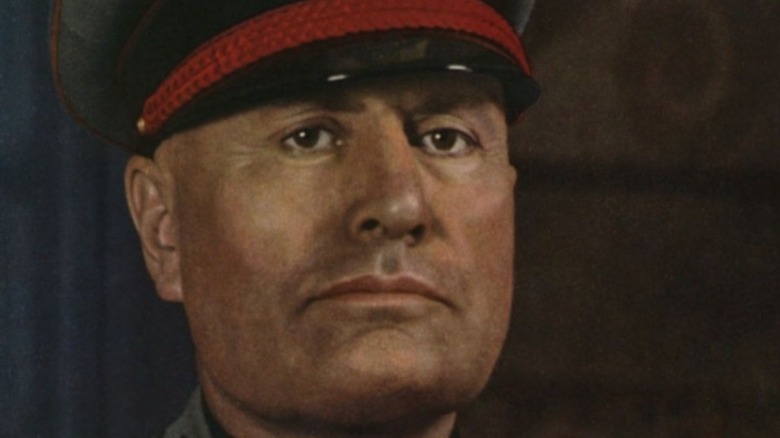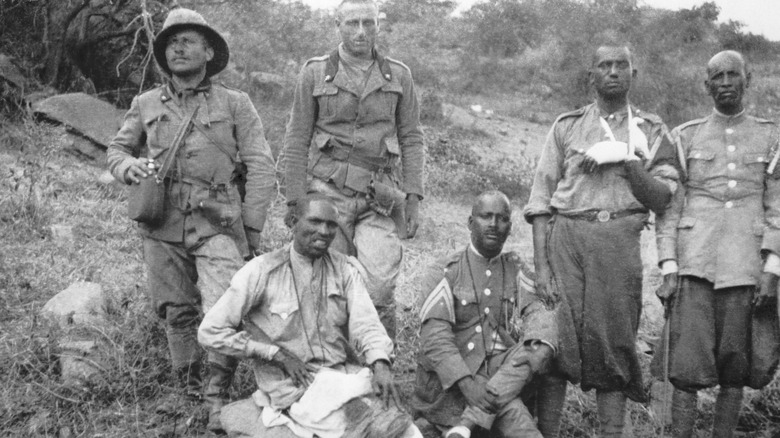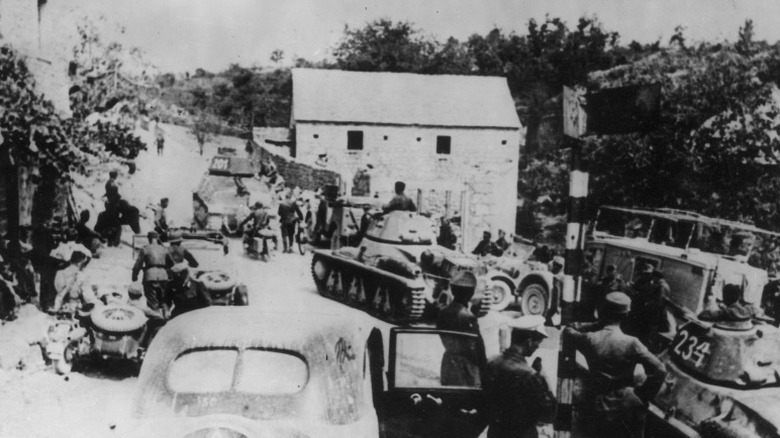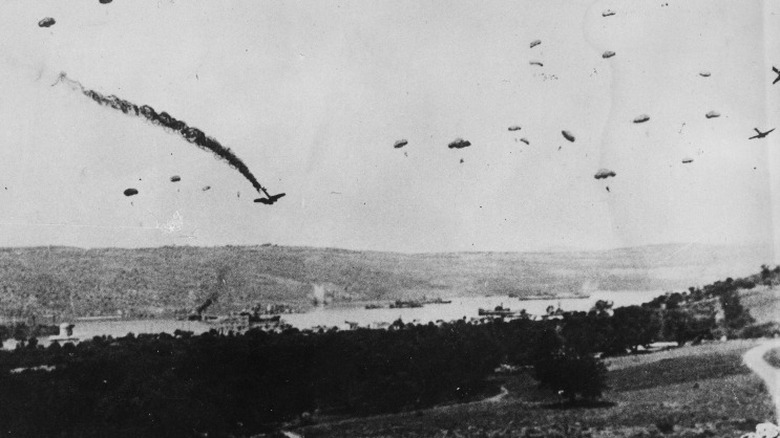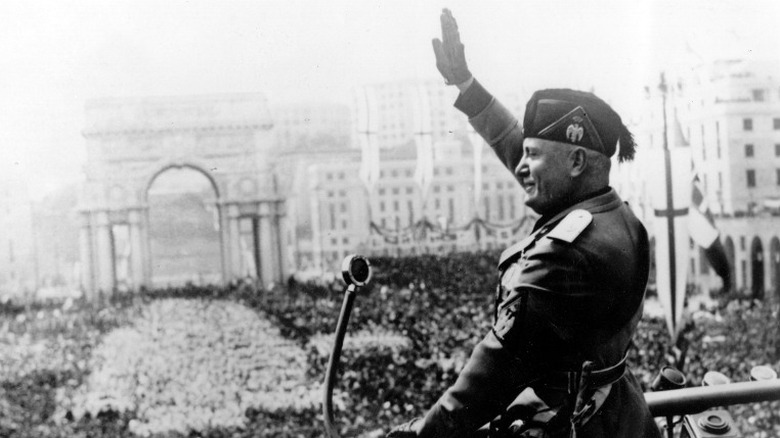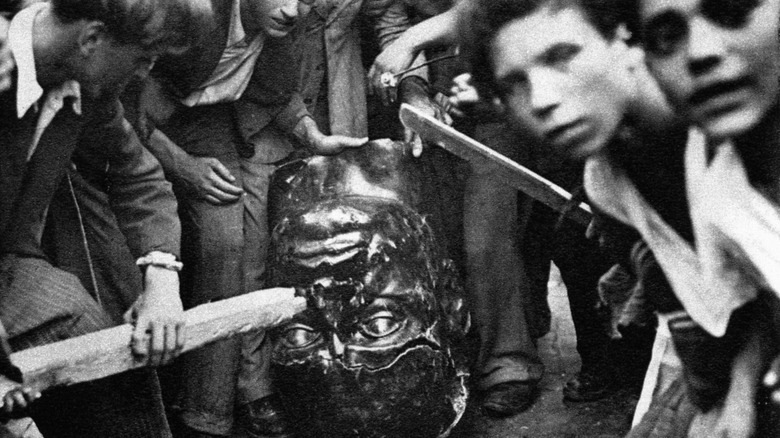How Mussolini Was Even More Evil Than You Think
The global atrocities committed before and during World War II are too numerous to quantify and were carried out by political and military leaders too numerous to fully mention. The scale of crimes against humanity against civilians is usually attributed to the two major members of the Axis powers: Germany and Japan. Indeed, the Nazi Holocaust that still haunts Europe to this day ran parallel with the Japanese brutality against the Chinese, Korean, and Filipino peoples.
While not as prominent of a figure during this war, Italian dictator Benito Mussolini was still as much of a monster. The fascist regime he established in 1921 quickly rose to absolute power in post-WWI Italy (via Life in Italy). In particular, fomenting changes in Italian election laws and procedures facilitated Mussolini's near-absolute iron hold on the country for over fifteen years.
The extent to which Mussolini would use brute force to not only hold on to his control but to also help fellow emerging fascist leader Adolf Hitler attempt to dominate all of Europe was unconscionable. From the execution of political opponents to the genocidal methods he ordered against the people of numerous countries, Mussolini deserves to be cemented in history as one of the evilest dictators of the last century.
Chemical warfare in Ethiopia
Italy made an unsuccessful attempt at occupying and controlling Abyssinia (modern-day Ethiopia) in the late 1890s (via Britannica). After this failure, Abyssinia stood as one of only a handful of independent nations on the entire African continent. Other European powers (the British and the French, especially) had spent the better part of the 19th century invading, colonizing, and exploiting the continent of its natural resources. After the decline of the African slave trade, the powers that be in Europe saw colonialism as the best and most profitable tactic in keeping the money coming in.
In 1935, Mussolini used a border dispute between Abyssinia and neighboring Somaliland as a public excuse to invade the country. By May of 1936, the capital city of Addis Ababa fell to the Italian army, which forced emperor Haile Selassie I into a forced exile (via Britannica). Mussolini sold the invasion to the Italian people as a method to get jobs to unemployed Italians and as a way to get another nation's natural resources into the hands of Italy. According to Mussolini, these resources were greatly needed to help combat the effects of the Great Depression (via South African History Online).
Under orders from Mussolini, the invading Italians used mustard gas as a chemical weapon to fight the poorly trained Abyssinian army (via the International Committee of the Red Cross). Such actions were a direct violation of the Geneva Convention, especially when considering that many of the gas attacks were against civilians and the Red Cross itself. All told, more than 100,000 Ethiopians died due to mustard gas poisoning (via War History Online).
Concentrating Yugoslavian citizens
Throughout most of the 1930s, the United States hoped to stay neutral to the Italian fascist regime. The thought was to have a potential ally against what they feared would be a conflict with the Germans, who were making some concerning moves in central Europe. Their worst fears were realized on May 22, 1939, when Mussolini and Hitler forged what the Italian dictator would call the "Pact of Steel." This was the beginning of the Axis Powers, who would later add Japan to their team in September of 1940 (via History).
On April 6, 1941, Germany and Italy launched simultaneous attacks on Yugoslavia and Greece. Greece was the last major ally of England still standing in Europe, and Yugoslavia had just ousted a fascist-friendly leader (via War History). In Yugoslavia, the invasion of Axis forces thrust the country into a civil war (via Modern Italian Studies). Italian General Mario Roatta ordered suspected enemies of the Italian army to be rounded up and executed on sight, and many others were carted off to concentration camps. The Italian army burned homes, razed villages, and destroyed farm grounds to solidify their position in Yugoslavia.
While things were getting bad for the Slovenians, the joint effort by the Axis powers on Greece was just getting underway.
The Greek invasion and subsequent famine
Meanwhile, Greece was suffering a large-scale invasion by Italian and German forces. Joined by Bulgaria in the invasion and occupation, the Axis powers placed the majority of Greece under the control of Mussolini (via World War II Wrecks). The Greeks, who had defeated Italy at war several years earlier, had strained their own resources to the breaking point. However, the Greek resistance to the Italian occupation was strong and ever-growing. Attacks on the invading forces were common but were met with harsh retaliation by Mussolini.
Anyone suspected of being a part of the Greek resistance was executed on sight. Entire villages were destroyed, as were farmlands, and civilians were executed by the dozens. But still, the resistance grew. Before they were finally driven out of Greece in 1943, the Italian army managed to plunge Greece into a famine. The plundering of their resources and destruction of their farms led to 300,000 Greeks starving to death (via WWII Database). Even after the Italians were successfully driven from their land, the Greek people suffered the Italian occupation for years.
The pacification of Libya
Before the start of World War I, Italy had managed to wrangle Libya away from the now-defunct Ottoman Empire (via TheInfoList). But from the beginning of the Italian occupation in 1912, resistance from Libya's people had been a growing problem for the occupiers. Finally, in 1920, Italy was forced to recognize Sayid Idris as leader and grant him autonomy over Libya. It seemed as though Libya would have a future free from Italian control.
This freedom was short-lived, however. When Mussolini consolidated power in Italy in 1923, he ordered an invasion over the previously occupied country. This resulted in a full-scale war between the Italian military and the Libyan resistance. The war raged on into 1930 when Mussolini ordered his military to commit brutal attacks against the civilians in Libya.
The Bedouins were expelled from the country, and many were forced into concentration camps. Civilians were shot daily in the streets or run over by tanks. There were reports of the Italian military taking Libyans onboard airplanes, only to torture them and then throw them to their deaths from mid-air. In the aftermath, it was also discovered that the Italian army had murdered innocent children and raped civilian Libyan women. Disease ran rampant throughout the concentration camps, and 40,000 of the 100,000 held in them ended up dying when they shuttered in 1933 (via TheInfoList).
Final days and execution
Thankfully, all things must come to an end. After fighting in World War II for three years, the Italian people were beginning to grow weary. Unprepared for a full-scale war to begin with, they were suffering from casualties on a large scale. Allied victories that swept across northern Africa had depleted much of Italy's military resources, and the Allies pushing Italy and Germany back on the eastern front weren't doing them any favors, either.
His own military leaders threatening to defect against him, Mussolini was forced to call into order the very Grand Council that gave him power (via Life in Italy). Mussolini received a vote of no confidence and was removed from power on July 25, 1943, after which he was arrested and exiled to the island of La Maddalena. Still, Germany wasn't going down without a fight. With Mussolini out of power, the Nazi forces invaded Italy, rescued Mussolini from his island prison, and placed him back in power over German-occupied north Italy. But when the Allied forces invaded Italy in 1945, Mussolini was forced to flee.
The ousted dictator left in his 1939 Alfa Romeo sportscar with his fiance, Claretta Petracci. But Mussolini's luck had run out. Recognized at a stop, he was captured and held prisoner with Claretta in a barn for the night (via History). Early the next morning, Mussolini and his date were executed by firing squad against a cement wall. Their bodies, along with the bodies of a dozen Nazi officers, were taken via truck and dumped onto the ground in a public square in Milan. The gathering crowd strung up the corpses of both Mussolini and Claretta, displaying to the world that, at last, Italy's fascist monster would be a threat to them no longer.
